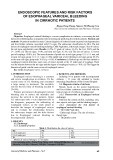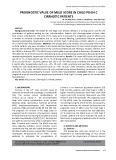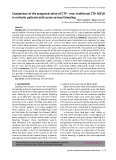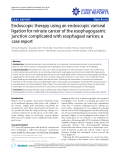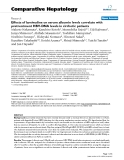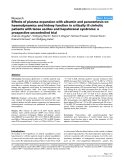
Journal of Medicine and Pharmacy - No.5 69
ENDOSCOPIC FEATURES AND RISK FACTORS
OF ESOPHAGEAL VARICEAL BLEEDING
IN CIRRHOTIC PATIENTS
Hoang Trong Thang, Nguyen Thi Phuong Uyen
Hue University of Medicine and Pharmacy, Vietnam
Abstract
Objective: Esophageal variceal bleeding is a severe complication in cirrhosis, so assessing the risk
factors for rebleeding play an important role in treating and predicting for cirrhotic patients. Patients and
methods: 84 patients enrolled in study. Criteria diagnosis of cirrhosis bazed on portal vein hypertension
and liver failure sydroma, associated with U.S signs. The endoscopic classification by JEA. The risk
factors of esophageal variceal bleeding including: Child Pugh index, endoscopic images: Size of varices,
the red signs and platelet count. Results: (i) The 3rd grade of varices: 46.4%, the 1rst: 28.6% and the
2nd: 25.0%; (ii) The red signs: 17.9%, and none red signs: 82.1%; (iii) The sites of varices: 1/3 lower
part of esophage: 80.9%; (iv) The mean diameter of portal vein in red signs group: 15.5 ± 1.1 mm, and
in none red signs group: 12.1 ± 1.7 mm; (v) The middle and severe bleeding in red signs group: 92.2%;
in the none red signs group only 76.5% (p < 0.05). Conclusion: (i) Endoscopy was the best method in
esophageal variceal detection, most cases of varices located at the 1/3 under part of esophage. There
was the relation between the red signs and the degree of esophageal varices p < 0.01; (ii) The bigger the
diameter of portal vein the more severe of esophageal varices.
Key words: Esophageal varice, cirrhosis
1. INTRODUCTION
Esophageal varices bleeding is a common
and severe complication in cirrhosis. It’s the
second cause in G.I bleeding and consumed
a large money in treatment. The mortality
rate for the first time of bleeding reached to
20-50%.
Primary prevention in Esophageal variceal
bleeding aim to reduce the mortality and
increase the survival to the patients. Upper
G.I endoscopy took a very important role in
the diagnosis, prognosis the rebleeding of
esophageal varices, so the study aimed to
describe the images of esophageal varices
and to evaluate the relationship between
the endoscopy images and the risks factors
due to Esophageal variceal bleeding in
decompensated cirrhosis.
2. PATIENTS AND METHODS
Including 84 in patients with decompensated
cirrhosis > 15 years old admitted to Gastro
enterology Department of Hue Central Hospital.
2.1. Diagnosis criteria of cirrhosis
Mainly based on the portal hypertension
and liver failure syndrome associated with the
typical signs of of cirrhosis on ultrasound.
2.1.1. Characteristic of Esophageal variceal
endoscopy
Followed the criteria of JEA, including: sites,
size, aspects, red signs, and the bleeding images.
2.1.2. Assesement the risk factors in
esophageal variceal bleeding
- The Child Pugh index
- Endoscopic images: The size of varices,
thered signs.
- The platelet count
3. RESULTS
3.1. Endoscopy
3.1.1. Located of varices
Table 1. Distribution the sites of varices
Site Pts %
1/3 of under part 68 80.9
2/3 of under part 16 19.1
Tol 84 100.0
Mostly of varices belong to 1/3 of under.
- Corresponding author: Hoang Trong Thang, email: htthang2002@yahoo.com
- Received: 12/5/2014 * Revised: 22/6/2014 * Accepted: 25/6/2014 DOI: 10.34071/jmp.2014.1e.12





